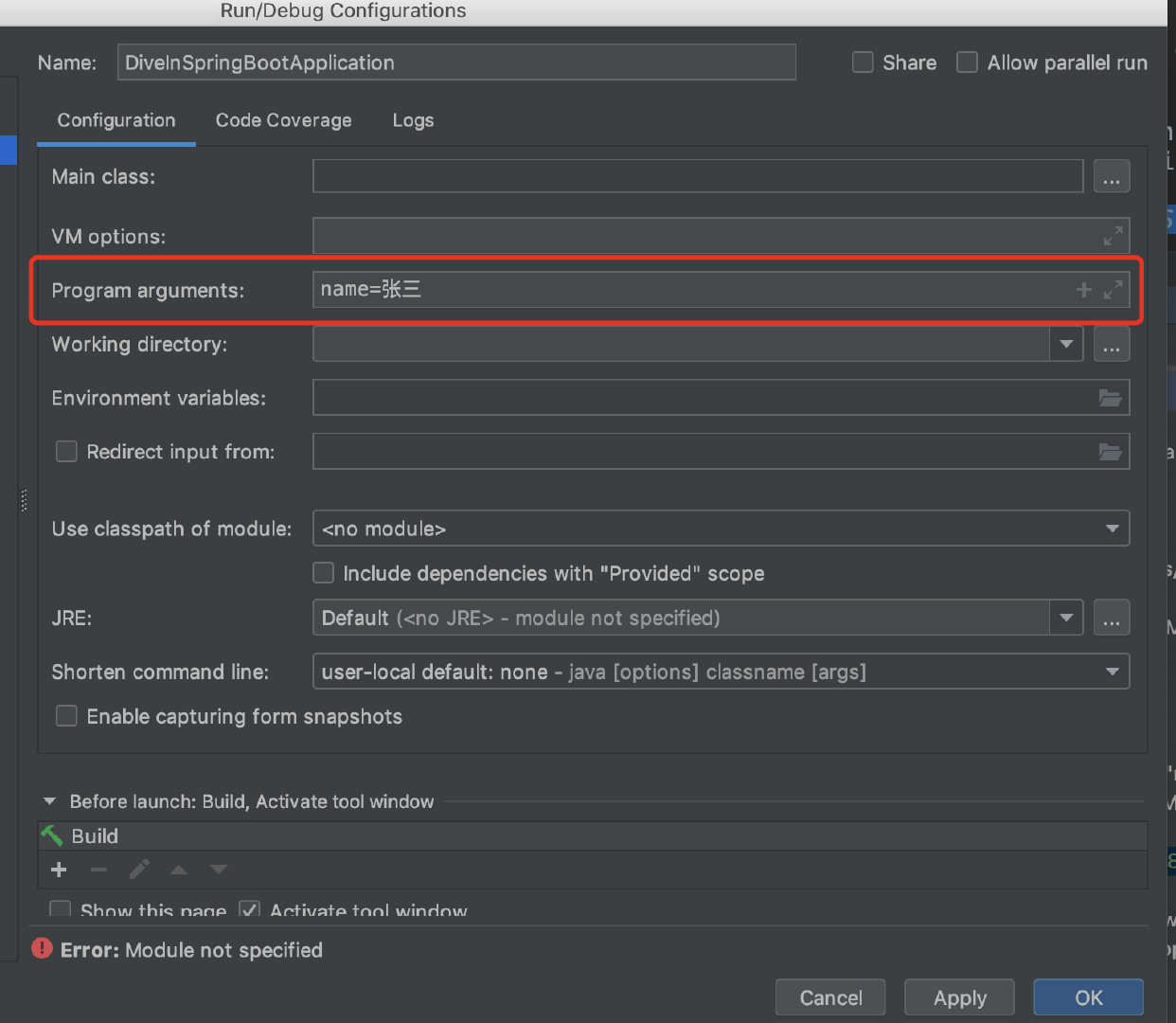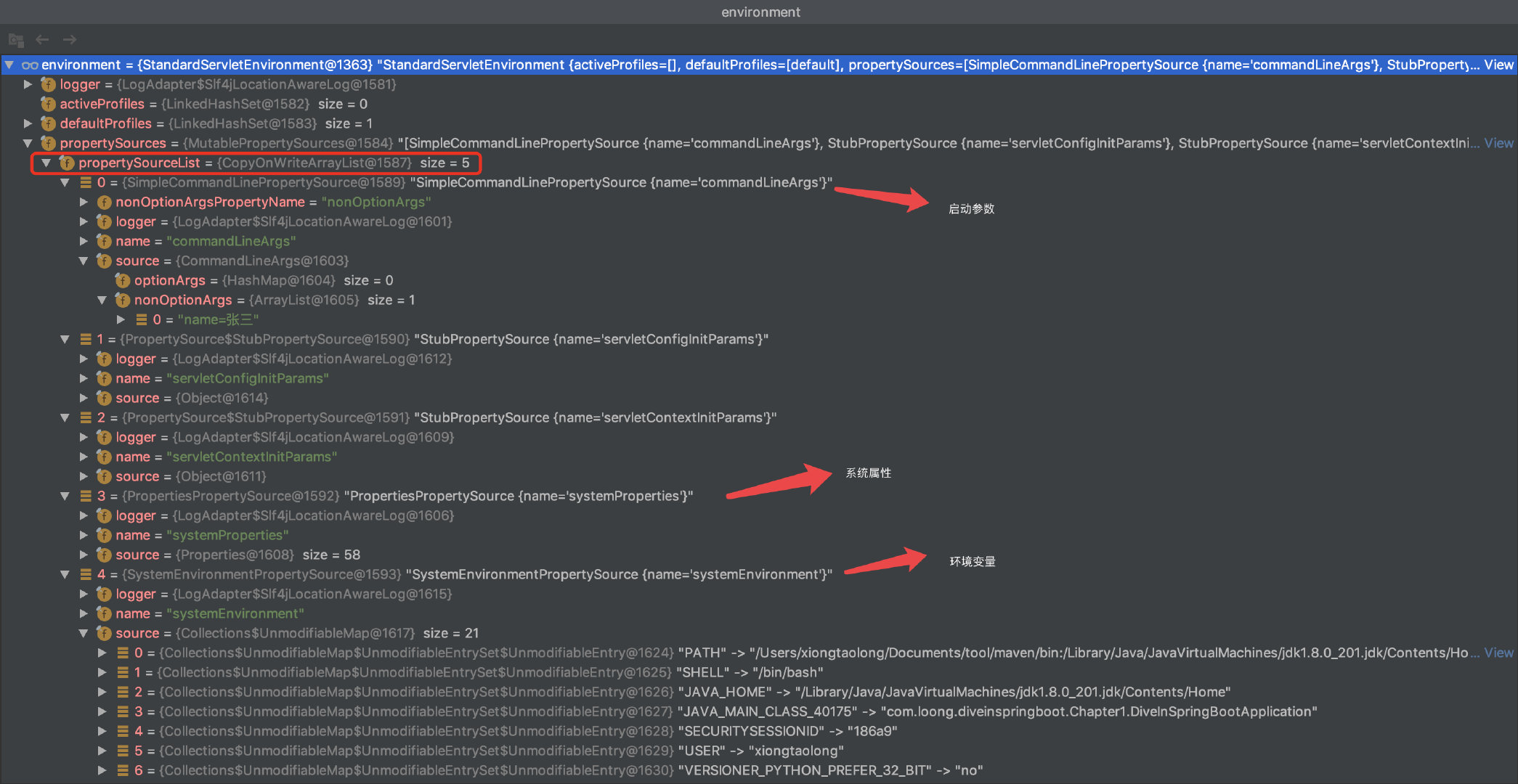前言
最近在学习Spring Boot相关的课程,过程中以笔记的形式记录下来,方便以后回忆,同时也在这里和大家探讨探讨,文章中有漏的或者有补充的、错误的都希望大家能够及时提出来,本人在此先谢谢了!
开始之前呢,希望大家带着几个问题去学习:
1、Spring Boot 外部化配置是什么?
2、整体流程或结构是怎样的?
3、核心部分是什么?
4、怎么实现的?
这是对自我的提问,我认为带着问题去学习,是一种更好的学习方式,有利于加深理解。好了,接下来进入主题。
1、起源
这篇文章我们就来讨论 Spring Boot 的外部化配置功能,该功能主要是通过外部的配置资源实现与代码的相互配合,来避免硬编码,提供应用数据或行为变化的灵活性。相信小伙伴们在日常工作中都有使用过,如在 properties 或者 YAML 文件中定义好key value格式的数据后,就可在程序中通过 @Value 注解获取该value值。还可以定义一些同外部组件约定好的key,如以 spring 或 redis 等组件名为前缀的key,之后相应的组件就可读取到该value值进行工作。当然,这只是外部化配置的一小部分内容,接下来进行详细讨论。
注:本篇文章所用到的
Spring Boot版本是2.1.6.BUILD-SNAPSHOT
2、外部化配置的资源类型
先来看看外部化配置的几种资源类型,除了 properties 和 YAML 外,还有环境变量、系统属性、启动参数等。所有的资源类型将近二十种,这里只介绍我们比较熟悉的:
- properties :这个应该都知道,就是在以
.properties为后缀的文件中定义key value格式数据。 - YAML:文件格式是以
.yml为后缀,文件中的数据也是key value格式,如下:
user:
name: loong
age: 10
这里的key就是 user.name 、 user.age 。
3. 环境变量:这是通过 System.getenv() 方式获取的默认配置,也是key value格式,下面列出部分配置,其它的还请自行了解,如下:
| 名称 | Key |
|---|---|
| Java安装目录 | JAVA_HOME |
| classpath环境变量 | CLASSPATH |
| 用户临时文件目录 | TEMP |
| 计算机名 | COMPUTERNAME |
| 用户名 | USERNAME |
- 系统属性:这是通过
System.getProperties()方式获取的默认配置,也是key value格式,下面列出部分配置,其它的还请自行了解,如下:
| 名称 | Key |
|---|---|
| 运行时环境版本 | java.version Java |
| Java安装目录 | java.home |
| 要使用的 JIT编译器的名称 | java.compiler |
| 操作系统的架构 | os.arch |
| 操作系统的版本 | os.version |
- 启动参数:这个在 《Spring Boot SpringApplication 启动类(二)》这篇文章中讨论过。一种是在
jar包运行时行时传递的参数,如:java -jar xxx.jar name=张三 pwa=123,还有一种是在 IDEA 的Program arguments中输入数据:

可以看到,外部化配置中的数据都是key value 格式。这里还要注意它们的加载顺序,当key相同时,会出现覆盖的情况。
3、外部化配置的核心
接下来,我们的重心来围绕 properties 和 YAML 配置文件,这两者也是我们日常工作中常用的。首先来看取值方式,在 Spring 时代有 Environment 、 @Value 、 XML 三种方式,在 Spring Boot 时代则是 @ConfigurationProperties 方式。其中,涉及到了一个核心类,它就是 Environment ,该对象不仅可以获取所有的外部化配置数据,就连另外几种取值方式的数据来源也是从该类中获取。这里,主要对 Environment 和 @ConfigurationProperties 进行详细讨论,笔者认为 Environment 和 @ConfigurationProperties 才是 Spring Boot 外部化配置的核心所在。
3.1 Environment
该类在 《Spring Boot SpringApplication启动类(二)》 的 2.3 章节有简要说明过,这里我们展开详细讨论。首先回顾一下代码:
public class SpringApplication {
...
public ConfigurableApplicationContext run(String... args) {
...
try {
...
ConfigurableEnvironment environment = prepareEnvironment(listeners, applicationArguments);
...
}
...
}
在 SpringApplication 运行阶段的 run 方法中通过 prepareEnvironment 方法了创建 ConfigurableEnvironment 的实现类对象,ConfigurableEnvironment 是一个接口,且继承了 Environment 。进入创建方法:
private ConfigurableEnvironment prepareEnvironment(SpringApplicationRunListeners listeners,
ApplicationArguments applicationArguments) {
ConfigurableEnvironment environment = getOrCreateEnvironment();
configureEnvironment(environment, applicationArguments.getSourceArgs());
listeners.environmentPrepared(environment);
bindToSpringApplication(environment);
if (!this.isCustomEnvironment) {
environment = new EnvironmentConverter(getClassLoader()).convertEnvironmentIfNecessary(environment,
deduceEnvironmentClass());
}
ConfigurationPropertySources.attach(environment);
return environment;
}
首先看第一行,通过 getOrCreateEnvironment 方法创建 ConfigurableEnvironment 对象:
private ConfigurableEnvironment getOrCreateEnvironment() {
if (this.environment != null) {
return this.environment;
}
switch (this.webApplicationType) {
case SERVLET:
return new StandardServletEnvironment();
case REACTIVE:
return new StandardReactiveWebEnvironment();
default:
return new StandardEnvironment();
}
}
在 《Spring Boot SpringApplication 启动类(二)》 的 2.3 章节说过, webApplicationType 存储的是应用的类型,有 Reactive、Servlet 等,是在 SpringApplication 准备阶段推导出来的,而本项目推导出来是 Servlet 类型,所以实例化的是 StandardServletEnvironment 对象:
public class StandardServletEnvironment extends StandardEnvironment implements ConfigurableWebEnvironment {
public static final String SERVLET_CONTEXT_PROPERTY_SOURCE_NAME = "servletContextInitParams";
public static final String SERVLET_CONFIG_PROPERTY_SOURCE_NAME = "servletConfigInitParams";
public static final String JNDI_PROPERTY_SOURCE_NAME = "jndiProperties";
@Override
protected void customizePropertySources(MutablePropertySources propertySources) {
propertySources.addLast(new StubPropertySource(SERVLET_CONFIG_PROPERTY_SOURCE_NAME));
propertySources.addLast(new StubPropertySource(SERVLET_CONTEXT_PROPERTY_SOURCE_NAME));
if (JndiLocatorDelegate.isDefaultJndiEnvironmentAvailable()) {
propertySources.addLast(new JndiPropertySource(JNDI_PROPERTY_SOURCE_NAME));
}
super.customizePropertySources(propertySources);
}
...
}
而该类又继承了 StandardEnvironment 类。且重写了 customizePropertySources 方法,并调用了父类的 customizePropertySources 方法。我们继续往下深入:
public class StandardEnvironment extends AbstractEnvironment {
public static final String SYSTEM_ENVIRONMENT_PROPERTY_SOURCE_NAME = "systemEnvironment";
public static final String SYSTEM_PROPERTIES_PROPERTY_SOURCE_NAME = "systemProperties";
@Override
protected void customizePropertySources(MutablePropertySources propertySources) {
propertySources.addLast(
new PropertiesPropertySource(SYSTEM_PROPERTIES_PROPERTY_SOURCE_NAME, getSystemProperties()));
propertySources.addLast(
new SystemEnvironmentPropertySource(SYSTEM_ENVIRONMENT_PROPERTY_SOURCE_NAME, getSystemEnvironment()));
}
}
继续看它的 AbstractEnvironment 父抽象类:
public abstract class AbstractEnvironment implements ConfigurableEnvironment {
...
private final MutablePropertySources propertySources = new MutablePropertySources();
...
public AbstractEnvironment() {
customizePropertySources(this.propertySources);
}
...
}
可以看到,最终会有一个 AbstractEnvironment 抽象类。在 StandardServletEnvironment 初始化时,会调用 AbstractEnvironment 的构造方法,里面调用了子类重写的 customizePropertySources 方法,且入参是 MutablePropertySources 对象,该对象是 Environment 的一个属性,是底层真正存储外部化配置的。之后, StandardServletEnvironment 和 StandardEnvironment 的 customizePropertySources 方法相继执行,主要是往 MutablePropertySources 对象中添加外部化配置。其中我们前面所说的环境变量和系统属性是在 StandardEnvironment 重写的方法中进行加载。
我们回到外面的 prepareEnvironment 方法,继续往下走。接着执行的是 configureEnvironment 方法,该方法主要是把启动参数加入到 MutablePropertySources 中。之后,我们断点看看有多少种外部化配置:

有五种,且真正存储数据的是 MutablePropertySources 中的 PropertySource 实现类集合。
这里简要介绍一下 PropertySource ,我们将其称之为配置源,官方定义它是外部化配置的API描述方式,是外部化配置的一个媒介。 用我们的话来说,它是一个抽象类,提供了统一存储外部化配置数据的功能,而每种外部化配置有具体的实现类,主要提供不同的基础操作,如 get、contains 等 。我们来看看 PropertySource 对象的数据格式,一般包含:
name : 外部化配置的名称
source : 存储配置中的数据,底层一般数据格式都是key value
我们继续往下走,接着调用了 SpringApplicationRunListeners 的 environmentPrepared 方法。在上篇文章
《Spring Boot SpringApplication 启动类(二)》 的 2.1 小节讲过,当 Spring Boot 执行到某一阶段时,会通过 Spring 的 SimpleApplicationEventMulticaster 事件广播器进行事件广播,之后 ,相应监听器就会监听到该事件,执行调监听器的 onApplicationEvent 方法。这里表示 Spring Boot 到了 ConfigurableEnvironment 构建完成时阶段。我们进入该方法:
class SpringApplicationRunListeners {
...
private final List<SpringApplicationRunListener> listeners;
public void environmentPrepared(ConfigurableEnvironment environment) {
for (SpringApplicationRunListener listener : this.listeners) {
listener.environmentPrepared(environment);
}
}
...
}
真正调用的是 SpringApplicationRunListener 集合中的 environmentPrepared 方法。 SpringApplicationRunListener 是一个接口,它具有唯一实现类 EventPublishingRunListener :
public class EventPublishingRunListener implements SpringApplicationRunListener, Ordered {
...
private final SimpleApplicationEventMulticaster initialMulticaster;
@Override
public void environmentPrepared(ConfigurableEnvironment environment) {
this.initialMulticaster
.multicastEvent(new ApplicationEnvironmentPreparedEvent(this.application, this.args, environment));
}
...
}
可以看到,最终通过 SimpleApplicationEventMulticaster 的 multicastEvent 方法发布 ApplicationEnvironmentPreparedEvent 事件。上面说过, Spring Boot 监听器会监听到该事件,其中一个名为 ConfigFileApplicationListener 的监听器,监听到该事件后会进行加载 application 和 YAML 配置文件的操作,接下来,我们具体的来看一看该类实现。
3.1.1、ConfigFileApplicationListener
我们直接进入该类:
public class ConfigFileApplicationListener implements EnvironmentPostProcessor, SmartApplicationListener, Ordered {
...
private static final String DEFAULT_SEARCH_LOCATIONS = "classpath:/,classpath:/config/,file:./,file:./config/";
public static final String CONFIG_NAME_PROPERTY = "spring.config.name";
public static final String CONFIG_LOCATION_PROPERTY = "spring.config.location";
public static final String CONFIG_ADDITIONAL_LOCATION_PROPERTY = "spring.config.additional-location";
private static final String DEFAULT_NAMES = "application";
@Override
public void onApplicationEvent(ApplicationEvent event) {
// 1、通过 instanceof 判断事件的类型,如果是 ApplicationEnvironmentPreparedEvent 事件,则执行 onApplicationEnvironmentPreparedEvent 方法
if (event instanceof ApplicationEnvironmentPreparedEvent) {
onApplicationEnvironmentPreparedEvent((ApplicationEnvironmentPreparedEvent) event);
}
...
}
private void onApplicationEnvironmentPreparedEvent(ApplicationEnvironmentPreparedEvent event) {
// 2、调用 loadPostProcessors 方法,返回 Environment 的后置处理器集合,我们跳到 2.1 查看方法实现
List<EnvironmentPostProcessor> postProcessors = loadPostProcessors();
// 2.2、把自己也加入该集合
postProcessors.add(this);
AnnotationAwareOrderComparator.sort(postProcessors);
// 2.3、遍历 EnvironmentPostProcessor 集合,执行它们的 postProcessEnvironment 方法,我们跳到 3 查看当前类的该方法实现
for (EnvironmentPostProcessor postProcessor : postProcessors) {
postProcessor.postProcessEnvironment(event.getEnvironment(), event.getSpringApplication());
}
}
// 2.1 是我们比较熟悉的 loadFactories 方法,在 Spring Boot 自动装配(二) 的 2.1.2 小节讲过,loadFactories 方法是从 spring.factories 文件中加载 key 为 EnvironmentPostProcessor 的实现类集合
List<EnvironmentPostProcessor> loadPostProcessors() {
return SpringFactoriesLoader.loadFactories(EnvironmentPostProcessor.class, getClass().getClassLoader());
}
// 3、 执行到该方法时,会调用 addPropertySources 方法,入参是上文加载 ConfigurableEnvironment 对象
@Override
public void postProcessEnvironment(ConfigurableEnvironment environment, SpringApplication application) {
addPropertySources(environment, application.getResourceLoader());
}
protected void addPropertySources(ConfigurableEnvironment environment, ResourceLoader resourceLoader) {
RandomValuePropertySource.addToEnvironment(environment);
// 4、 我们主要关注这里,通过 Loader 的构造方法创建该对象,并调用它的 load 方法
new Loader(environment, resourceLoader).load();
}
private class Loader {
private final ConfigurableEnvironment environment;
private final List<PropertySourceLoader> propertySourceLoaders;
// 4.1、 构造方法中会初始化一些属性
Loader(ConfigurableEnvironment environment, ResourceLoader resourceLoader) {
...
this.environment = environment;
// 又是我们比较熟悉的 loadFactories 方法,在 Spring Boot 自动装配(二) 的 2.1.2 小节讲过,loadFactories 方法是从 spring.factories 文件中加载 key 为 PropertySourceLoader 的实现类集合。这里加载的是 PropertiesPropertySourceLoader 和 YamlPropertySourceLoader 两个实现类,看类名可初步断定是处理 properties 和 YAML 文件的
this.propertySourceLoaders = SpringFactoriesLoader.loadFactories(PropertySourceLoader.class,getClass().getClassLoader());
}
public void load() {
...
// 5、这里会继续调用它重载的 load 方法
load(null, this::getNegativeProfileFilter, addToLoaded(MutablePropertySources::addFirst, true));
...
// 9、这是最后一步,将当前类中的 MutablePropertySources 中的 PropertySource 对象,全部塞到 ConfigurableEnvironment 的 MutablePropertySources 对象中。我们跳到 9.1 进行查看
addLoadedPropertySources();
}
private void load(Profile profile, DocumentFilterFactory filterFactory, DocumentConsumer consumer) {
// 5.1、首先执行 getSearchLocations 方法,看方法名大致能猜出是获取搜索路径的,我们跳到 5.1.1 查看该方法的实现
getSearchLocations().forEach((location) -> {
// 5.2、开始遍历该集合,先判断该路径是否是以反斜杠结尾,是的话则该路径为文件夹;不是的话,则该路径为文件的完整路径,类似于 classPath:/application.properties
boolean isFolder = location.endsWith("/");
// 5.3、 如果是文件夹路径,则通过 getSearchNames 获取文件的名称,不是则返回空集合,我们跳到 5.3.1 查看 getSearchNames 方法
Set<String> names = isFolder ? getSearchNames() : NO_SEARCH_NAMES;
// 5.4、再调用 load 的重载方法,这里,location 是路径名,name是文件名,我们跳到 6 进行查看
names.forEach((name) -> load(location, name, profile, filterFactory, consumer));
});
}
// 5.1.1、这个方法就是获取加载 application 和 YAML 文件路径的
private Set<String> getSearchLocations() {
// 可以看到 CONFIG_LOCATION_PROPERTY 的值为 spring.config.location,也就是说,先判断我们有没有手动设置搜索路径,有的话直接返回该路径。该值一般通过启动参数的方式设置
if (this.environment.containsProperty(CONFIG_LOCATION_PROPERTY)) {
return getSearchLocations(CONFIG_LOCATION_PROPERTY);
}
// 该 CONFIG_ADDITIONAL_LOCATION_PROPERTY 变量的值为 spring.config.additional-location,这也是用于手动设置搜索路径,不过和上面不同的是,不会覆盖 接下来默认的搜索路径
Set<String> locations = getSearchLocations(CONFIG_ADDITIONAL_LOCATION_PROPERTY);
// 这里就是获取默认的搜索路径,通过 DEFAULT_SEARCH_LOCATIONS 变量的值 classpath:/,classpath:/config/,file:./,file:./config/,将该值用逗号分隔,加入集合并返回。到这一步,我们至少获取到了4个加载 application 和 YAML 文件的路径
locations.addAll(asResolvedSet(ConfigFileApplicationListener.this.searchLocations, DEFAULT_SEARCH_LOCATIONS));
return locations;
}
// 5.3.1
private Set<String> getSearchNames() {
// CONFIG_LOCATION_PROPERTY 变量值为 spring.config.name ,同样先判断有没有手动设置文件名称,有的话,直接返回
if (this.environment.containsProperty(CONFIG_NAME_PROPERTY)) {
String property = this.environment.getProperty(CONFIG_NAME_PROPERTY);
return asResolvedSet(property, null);
}
// 如果没有,则通过 DEFAULT_NAMES 变量值返回默认的文件名,变量值为 application
return asResolvedSet(ConfigFileApplicationListener.this.names, DEFAULT_NAMES);
}
// 6、
private void load(String location, String name, Profile profile, DocumentFilterFactory filterFactory,
DocumentConsumer consumer) {
// 6.1、 上面 5.2 说过 name 为空时,表示 location 是完整的文件路径。之后进入这个 if
if (!StringUtils.hasText(name)) {
// 6.1.1、propertySourceLoaders 属性是在 4.1 处被初始化的,存储的是 PropertiesPropertySourceLoader 和 YamlPropertySourceLoader 两个类。这里对这两个类进行遍历
for (PropertySourceLoader loader : this.propertySourceLoaders) {
// 我们跳到 6.1.2 查看 canLoadFileExtension 方法实现,入参 location 是文件的完整路径
if (canLoadFileExtension(loader, location)) {
// 这里又是一个 load 重载方法,我们跳到 7 进行查看
load(loader, location, profile, filterFactory.getDocumentFilter(profile), consumer);
return;
}
}
}
Set<String> processed = new HashSet<>();
for (PropertySourceLoader loader : this.propertySourceLoaders) {
// 6.2 这里和 6.1.3 类似,获取文件扩展名
for (String fileExtension : loader.getFileExtensions()) {
if (processed.add(fileExtension)) {
// 进入 6.3、查看该方法实现。关注重点的两个参数:一个是路径名 + 文件名,还有一个 “.” +文件扩展名
loadForFileExtension(loader, location + name, "." + fileExtension, profile, filterFactory,
consumer);
}
}
}
}
// 6.1.2、 该方法作用是 判断 name 完整路径名是否以指定的文件扩展名结尾
private boolean canLoadFileExtension(PropertySourceLoader loader, String name) {
// 6.1.3、调用 PropertySourceLoader 的 getFileExtensions 方法。当你的实现类是 PropertiesPropertySourceLoader 时,该方法返回 properties、xml;如果是 YamlPropertySourceLoader 则返回 yml、yaml。从这里可以看出,能被处理的文件格式有这四种
return Arrays.stream(loader.getFileExtensions())
.anyMatch((fileExtension) -> StringUtils.endsWithIgnoreCase(name, fileExtension));
}
// 6.3 到了这里,prefix 和 fileExtension 都是进行拼接好的值,如 prefix = classpath:/applicarion,fileExtension = .properties
private void loadForFileExtension(PropertySourceLoader loader, String prefix, String fileExtension,
Profile profile, DocumentFilterFactory filterFactory, DocumentConsumer consumer) {
...
// 这里同样调用节点 7 的重载方法,通过 prefix + fileExtension 形成完整的文件路径名,通过入参进行传递。如 classpath:/applicarion.properties
load(loader, prefix + fileExtension, profile, profileFilter, consumer);
}
// 7、
private void load(PropertySourceLoader loader, String location, Profile profile, DocumentFilter filter,
DocumentConsumer consumer) {
try {
// 这里调用 ResourceLoader 的 getResource 方法,通过 location 文件路径,读取获取该文件资源,之后就好办了
Resource resource = this.resourceLoader.getResource(location);
...
// 具体解析在过程 loadDocuments 中,这里就不继续跟踪了,大致是以流的方式解析文件。解析之后会生成一个 PropertySource 对象,该对象在上面说过,表示一个外部化配置源对象,存储配置中的数据。之后,会将该对象封装到 Document 中
List<Document> documents = loadDocuments(loader, name, resource);
...
if (!loaded.isEmpty()) {
// 遍历 documents 集合,当执行 consumer.accept 时会进入 addToLoaded 方法,这是 Java8 的写法。consumer 对象参数来自节点 5 。我们跳到 8 查看 addToLoaded 实现
loaded.forEach((document) -> consumer.accept(profile, document));
if (this.logger.isDebugEnabled()) {
StringBuilder description = getDescription("Loaded config file ", location, resource, profile);
this.logger.debug(description);
}
}
}
catch (Exception ex) {
throw new IllegalStateException("Failed to load property " + "source from location '" + location + "'",
ex);
}
}
// 8、BiConsumer 是 JAVA8 的函数接口,表示定义一个带有两个参数且不返回结果的操作,通过节点 5 我们知道,这个操作是 MutablePropertySources::addFirst 。
private DocumentConsumer addToLoaded(BiConsumer<MutablePropertySources, PropertySource<?>> addMethod,
boolean checkForExisting) {
return (profile, document) -> {
if (checkForExisting) {
for (MutablePropertySources merged : this.loaded.values()) {
if (merged.contains(document.getPropertySource().getName())) {
return;
}
}
}
MutablePropertySources merged = this.loaded.computeIfAbsent(profile,
(k) -> new MutablePropertySources());
// 当调用 BiConsumer 的 accept 方法时,定义的操作会执行,两个入参分别是 MutablePropertySources 对象和配置文件源对象 PropertySource。该操作会调用 MutablePropertySources 的 addFirst 方法把该配置文件源对象添加至其中。最后我们去看看前面 load 方法中的最后一步 9
addMethod.accept(merged, document.getPropertySource());
};
}
// 9.1
private void addLoadedPropertySources() {
// 获取当前上下文环境中的 MutablePropertySources 对象
MutablePropertySources destination = this.environment.getPropertySources();
// 获取当前类中的 MutablePropertySources 集合
List<MutablePropertySources> loaded = new ArrayList<>(this.loaded.values());
Collections.reverse(loaded);
String lastAdded = null;
Set<String> added = new HashSet<>();
// 遍历 loaded 集合及其中所有的 PropertySource ,也就是 application 或 YAML 配置文件源对象
for (MutablePropertySources sources : loaded) {
for (PropertySource<?> source : sources) {
if (added.add(source.getName())) {
// 我们进入 9.2 查看该方法,主要参数是上下文环境中的 MutablePropertySources 对象和配置文件源对象
addLoadedPropertySource(destination, lastAdded, source);
lastAdded = source.getName();
}
}
}
}
// 9.2
private void addLoadedPropertySource(Mutab lePropertySources destination, String lastAdded,
PropertySource<?> source) {
if (lastAdded == null) {
if (destination.contains(DEFAULT_PROPERTIES)) {
destination.addBefore(DEFAULT_PROPERTIES, source);
}
else {
destination.addLast(source);
}
}
else {
// 最后通过将 source 添加到 environment 中的 MutablePropertySources 对象中。
destination.addAfter(lastAdded, source);
}
}
// 至此,properties 和 YAML 配置文件就被加载到了上下文环境共享的 Environment 中,之后如 @Value 等获取值都是从该对象中获取
}
}
可以看到,ConfigFileApplicationListener 主要功能就是将 properties 和 YAML 文件加载到 Environment 中。另外还存在一个 @PropertySource 注解,也是加载指定的配置文件到 Environment 中。
3.1.2、关联 SpringConfigurationPropertySources
我们回到最外面的 prepareEnvironment 方法,来看看执行完监听方法时 ConfigurableEnvironment 中加载了多少种外部化配置:

有七种,包括新增的 properties 配置文件。
之后还有一个操作,通过 ConfigurationPropertySources.attach 关联 SpringConfigurationPropertySources 类,该类主要是做一个适配器的工作,将 MutablePropertySources 转换为 ConfigurationPropertySource,下一小节将会用到对象。我们进入 attach 方法查看:
public final class ConfigurationPropertySources {
private static final String ATTACHED_PROPERTY_SOURCE_NAME = "configurationProperties";
public static void attach(Environment environment) {
Assert.isInstanceOf(ConfigurableEnvironment.class, environment);
// 获取 ConfigurableEnvironment 中的 MutablePropertySources
MutablePropertySources sources = ((ConfigurableEnvironment) environment).getPropertySources();
// 获取名为 configurationProperties 的外部化配置源对象
PropertySource<?> attached = sources.get(ATTACHED_PROPERTY_SOURCE_NAME);
// 如果存在,则把该对象移除
if (attached != null && attached.getSource() != sources) {
sources.remove(ATTACHED_PROPERTY_SOURCE_NAME);
attached = null;
}
// 不存在,则添加一个配置源对象,具体对象类型为 ConfigurationPropertySourcesPropertySource,源对象中的数据为 SpringConfigurationPropertySources
if (attached == null) {
sources.addFirst(new ConfigurationPropertySourcesPropertySource(ATTACHED_PROPERTY_SOURCE_NAME,
new SpringConfigurationPropertySources(sources)));
}
}
}
到这里,ConfigurableEnvironment 又新增了一个 ConfigurationPropertySourcesPropertySource 类型的配置源对象。我们主要来关注 SpringConfigurationPropertySources 对象,可以看到,这里是通过它的带参构造器创建该对象,参数 sources 是从 ConfigurableEnvironment 中获取的 MutablePropertySources 对象。我们进入 SpringConfigurationPropertySources 类中查看:
class SpringConfigurationPropertySources implements Iterable<ConfigurationPropertySource> {
...
private final Iterable<PropertySource<?>> sources;
SpringConfigurationPropertySources(Iterable<PropertySource<?>> sources) {
Assert.notNull(sources, "Sources must not be null");
this.sources = sources;
}
...
}
可以看到,外部 ConfigurableEnvironment 的 MutablePropertySources 关联到了该类中的 Iterable (继承关系) 对象,这就是在进行适配工作。
至此, Environment 的创建过程及加载外部化配置的过程就到这里结束,我们简要回顾一下该流程:
- 首先
Environment是一个较为特殊的类,术语称之为应用运行时的环境。它存储了所有的外部化配置,可以通过它获取任意配置数据,并且@Value、@ConfigurationProperties等其它获取配置数据的方式都依赖于该类。 - 通过判断应用的类型,来创建不同环境的
Environment,有Servlet、Reactive、非 Web 类型。 - 之后会相继添加外部化配置到该类中,每种外部化配置都对应了一个
PropertySource配置源对象。 - 重点介绍了加载
properties和YAML的方式。主要是通过回调Spring Boot的监听器ConfigFileApplicationListener进行处理。
加载完之后,就可以在应用中通过 @Autowired 注入该对象,获取任意外部化配置属性。
接下来要讨论的是在 Spring Boot 时代是如何通过 @ConfigurationProperties 来获取配置属性的。因篇幅过长, @ConfigurationProperties 内容另起一章。